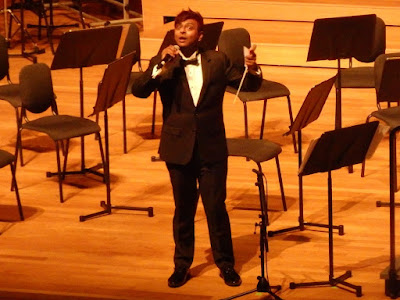BEETHOVEN’S NINTH:
YOUR CONCERT EXPERIENCE
Musicians’ Initiative
SOTA Concert Hall
Saturday (7 December 2024)
Some cultures celebrate the Christmas season with Beethoven’s Choral Symphony. Singapore is not one of these, but it is still a welcome prospect to be greeted with the Ode To Joy. Many Beethoven 9 concerts have it as the sole item on the programme, but Musicians’ Initiative led by Alvin Arumugam preceded its concert with an unusual hour-long first half with what is likely to have been three Singapore premieres.
The ostensible theme of the concert was a journey from darkness to light, and the world desperately needs that kind of inspiration now. The music of pioneering Japanese composer, the Berlin-schooled Kosaku Yamada (1886-1965), opened the concert. His Madara No Hana (The Spotted Flower, 1913) is a short tone poem which assimilated the influences must have had during his years of study – post-Wagnerian Tristanesque harmonies, impressionist hues and spurts of Richard Straussian lyricism. With neither whiffs of sakura nor sake, it made for a pleasant atmospheric overture.
 |
| Alvin introduces the works in his own passionate way. |
What came next was unprecedented, two double bass concertos with the excellent Atlanta-based Korean bassist Mikyung Sung. The Asian premiere of Dark with Excessive Bright (2018) by American composer Missy Mazzoli (born 1980), inspired by John Milton’s Paradise Lost, was revelatory.
Written in a single movement, its all-string accompaniment resembled that in a baroque concerto grosso supporting Sung’s tour de force, which spanned the full gamut of bass technique. This encompassed subterranean growls, gentle caresses to wild lashings, within an idiom that was tonal and at many parts lyrical. The tintinnabuli of Arvo Pärt’s spiritual minimalism was also in evidence. Towards the end, Sung’s touching duo with the orchestra’s bass Sanche Jagatheesan made for a sublime minute or so before a quiet and gentle close.
Far more traditional was Italian bass-virtuoso Giovanni Bottessini’s Double Bass Concerto No.2 in B minor, which had all the early Romantic virtuoso tropes – bel canto lyricism, transcendental technique and showboating for its own sake. Sung is an understated virtuoso, whose technique is wholly in service to the music. Adapting very well to both vastly diverse idioms, her intonation was always impeccable and made the unwieldy instrument sing. When a bass in its highest registers begins to resemble a cello, one is in the presence of a true master.
The main event was Beethoven’s Ninth Symphony in D minor (Op.125), popularly known as the Choral Symphony. The smallish orchestral forces employed by conductor Arumugam meant it was going to be lithe and light, much in the spirit of the period instrument movement. Heard on modern instruments, it was still a valid approach. Its opening, almost featherlight in its lift and very little vibrato used, would inform the tenor of the performance. The brisk speeds obligated very accurate playing and the orchestra obliged, the pinpoint pacing dictated by timpanist Christian Borres being a very dominant figure.
The Scherzo was just as swift and emphatic, with woodwinds in tiptop and unimpeachable form. This conception, which worked very well in the first two movements, was becoming reminiscent of a famous recording in the catalogue, the London Classical Soloists under Roger Norrington.
The Adagio was less immaculate, but unfolded in an unfussy and non-sentimental manner reaching a passionate climax before clocking in at just eleven minutes (Bernstein in Berlin ‘89 took over 20 minutes). With more rehearsal time, this would have been much better.
And so to the much-awaited finale. Erupting with appropriate tumult, themes from earlier movements were relived before the An der Freude theme began to take shape. Just seven cellos and four basses meant the required heft was missing, a price to pay for the earlier litheness. Baritone John Lee was the perfect choice to voice the opening O Freunde, nicht diese Töne!, his stentorian presence a reassurance. Less impressive was tenor Raymond Lee who was virtually drowned out by the janissary band in the Turkish march episode. The quartet was soloists was completed by soprano Teng Xiang Ting and mezzo-soprano Cindy Honanta who were excellent.
Pride of place had to go to the 74-strong Symphonia Choralis (Chong Wai Lun, chorusmaster) which was very well-disciplined and delivered the choral climaxes and tricky fugues with suitable aplomb. The unison Seid umschlungem, Millionen was particularly arresting, hair-raising in intensity but with no hair out of place. As everybody knows, this was Friedrich Schiller’s paean to the “Brotherhood of Man”, the unfettered joy displayed by orchestra, chorus and soloists evident to all who were fortunate to have attended.
This was clearly the most impressive showing to date by Musicians’ Initiative under music director Alvin Arumugam. Their future concerts will be keenly anticipated.
Enjoy the concert here:



















No comments:
Post a Comment